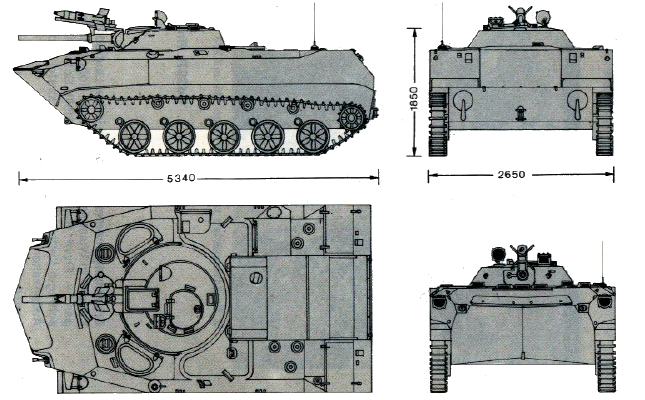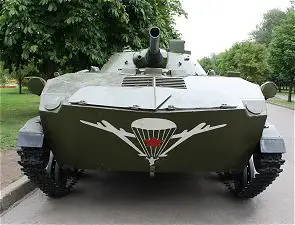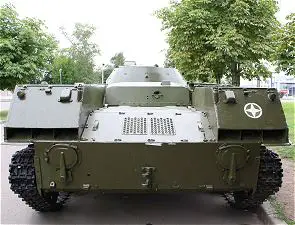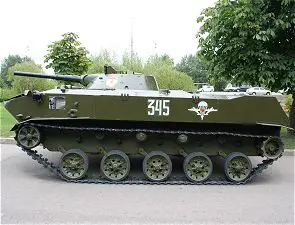| |
| |
|
|
| |
| Description |
|
The BMD-1 is an airborne tracked armoured infantry fighting vehicle, which entered into the service with the Russian Army airborne units in 1969 and was first shown to the public during a parade held in Moscow in November 1973. The vehicle was called the M1970 before its Russian designation became known. Development started in 1965 and limited production began in 1968 and ended in 1969. After operational trials it was deployed in limited numbers by 1969 and the serial production started in 1970, although the vehicle weight 500 kg more than what the requirements stated (7.5 tonnes and 13.3 tonnes when loaded with equipment). In the late 1970s a new modernized vehicle received the designation BMD-1P following the adoption of the new 9P135M-1 ATGM launcher instead of 9S428 ATGM launcher, firing the 9M113 "Konkurs" (AT-5 Spandrel). In 1983, based on the combat experience in Afghanistan a decision was made to produce a new variant of the BMD with a weapon capable of engaging targets such as those faced by the airborne troops in that conflict. This resulted in "Ob'yekt 916" which later became BMD-2. A lengthened chassis of BMD-1 served as a basis for the BTR-D airborne multi-purpose tracked APC which itself served as a basis for many specialized airborne vehicles. The BMD-1 is always currently used by the Russian airborne troops. BMD-1 and BMD-1PK IFVs are used by Russian airborne units of KFOR. BMD-1 IFVs were used by Russian airborne units of SFOR.
|
| |
|
BMD-1 Variants :
|
- BMD-1K (K stands for komandirskaya - command) - Command variant fitted with R-126 and R-107 transceivers, two Clothes Rail antennas and a generator box. It's sometimes called BMD-K.
BMD-1P - BMD-1 modernization with its 9S428 ATGM launcher replaced by pintle-mounted 9P135M-1 ATGM launcher capable of firing 9M113 "Konkurs" (AT-5 Spandrel), 9M113M "Konkurs-M" (AT-5B Spandrel B), 9M111 "Fagot" (AT-4 Spigot) and 9M111-2 "Fagot" (AT-4B Spigot B) ATGMs. Entered service in 1977.
- BMD-1PK (K stands for komandirskaya - command) - Command variant of BMD-1P. It is fitted with an additional R-123M radio set, a generator, the GPK-59 gyroscopic compass, the PRKhR radiation and chemical reconnaissance unit and two attachable tables. The machine gun mounted in the left corner of the bow of the hull has been eliminated as well as one of the seats. The crew consists of 6 men. The ammo load was reduced by one 9M113 "Konkurs" (AT-5 Spandrel) ATGM and 250 7.62 mm machine gun rounds.
- BMD-1P: The sagger launcher system is removed from the gun and on the roof is a pintle launcher for AT-4 Spigot.
- BMD-1M: - BMD-1 with smoke grenade launchers on the rear of the turret, improved ventilation and road wheels.
- BTR-D: BMD-1 without turret and a longer chassis with six road wheels.
- BTR-ZD: a ZU-23-2 anti-aircraft gun is mounted at the top of the hull
- BMD-KShM: command post vehicle
- BMD-1 Shmel-1 RPV: A BMD-1KShM chassis is used as the launcher and flying control station for the Shmel-1 remotely piloted vehicle.
- BRehM-D: based on BTR-D with equipment for recovery and repair.
- BMD-1 R440 ODB: communication vehicle with satellite communications system mounted to the roof.
- 1V118 Reostat: This is the BMD-1 chassis with its turret removed. It is used as an artillery observation vehicle fitted with surveillance and acquisition radar.
- 1V119 Spektr: This is the BMD-1 chassis with its turret removed. It is used as an artillery fire direction centre with the 2S9.
- 2S9 SO-120 Nona: equipped with a mortar turret 120 mm.
- BMD-1 with its 73 mm 2A28 "Grom" main gun replaced by 30 mm autocannon.
- BMD-1 with its 73 mm 2A28 "Grom" main gun replaced by 30 mm AGS-17 "Plamya" automatic grenade launcher.
- BMD-1 converted into a mortar carrier.
- BMD-1 converted into a self-propelled multiple rocket launcher. The armament was removed and replaced by a vision device. Fitted on top of the turret is a small box-type launcher for 12×80 mm rockets. |
|
| |
|
|
|
|
| |
| Armament |
|
The vehicle is armed with the 73 mm 2A28 Grom gun and 7.62 mm PKT coaxial tank machine gun. Mounted on the mantlet is the 9S428 ATGM launcher capable of firing 9M14 "Malyutka" (NATO: AT-3A Sagger A) and 9M14M "Malyutka-M" (NATO: AT-3B Sagger B) ATGMs (for which the vehicle carries 2 ATGMs in the turret). There are also two 7.62 mm PKT machine guns in fixed mounts, one each in the corners of the bow.
|
| Protection |
|
The hull and the turret of the BMD-1 are welded aluminium. Armour thickness is 23 mm at 42° on the front of the turret, 19 mm at 36° on the sides of the turret, 13 mm at 30° on the rear of the turret, 6 mm on the rear of the turret, 15 mm on the front of the hull and 10 mm on the rest of the hull
|
| Propulsion |
|
The BMD-1 is motorised with 5D-20 V-6 liquid-cooled diesel developing 240 hp. The independent suspension on either side consists of five small roadwheels with the idler at the front and the drive sprocket at the rear. There are four track-return rollers. The independent suspension combines a hydraulic system for altering the ground clearance and maintaining track tension with pneumatic springs, enabling the ground clearance to be altered from 100 to 450 mm.
|
| Accessories |
|
The BMD-1 is fully amphibious and is propelled in the water by two water jets at the rear of the hull. Before entering the water a trim vane, which is stowed on the glacis plate when not in use, is erected at the front of the hull. The water entry points (for the water jets) are located on either side under the hull rear. The vehicle has electric and manual bilge pumps, a GPK-59 gyrocompass, an engine preheater, smoke-generating equipment, a PAZ NBC system and a PPO centralised ethylene-bromide fire extinguishing system as fitted to other Russian armoured vehicles. BMD-1 airborne infantry combat vehicles are reported to be equipped with a radio `bleeper' device that allows their crews, who are equipped with direction-finding equipment, to locate their own individual BMD-1 when they are parachuted onto the drop zone.
|
| |
| Specifications |
| |
|
Armament
|
|
One 73 mm gun, 3 PKT 7.62 mm machine guns, 1 launcher unit for anti-tank missile AT-3 Sagger.
|
|
Designer - Manufacturer
|
|
Arkadyi Shabalin - Volgograd Tractor Plant
|
|
Country users
|
|
Angola, Armenia, Azerbaijan, Belarus, India, Iraq, Moldova, Russia, Ukraine, Uzbekistan.
|
|
Crew
|
|
3 + 4 soldiers
|
|
Accessories
|
|
Night vision, NBC protection system
|
|
|
Armour
|
|
Welded aluminium for hull and turret. Hull 15mm, turret 23mm.
|
|
Weight
|
| 7,500 kg |
|
Speed
|
|
70 km/h on road, 10 km/h on water
a
|
|
Range
|
|
320 km
|
|
Dimensions
|
|
Length, 5,4 m; Width, 2,63 m; Height, 1,97 m
|
|
|
| |
|
|
| |
|
|
| |
|
|
|
|
|

































